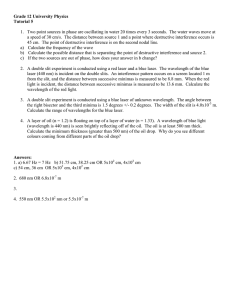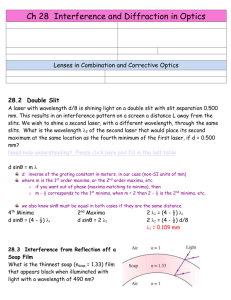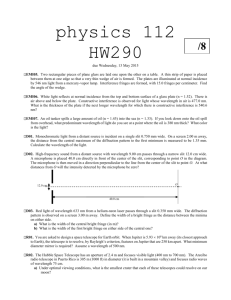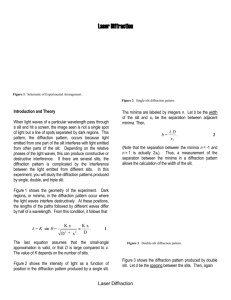diffraction and interference physics 205 lab 3
advertisement
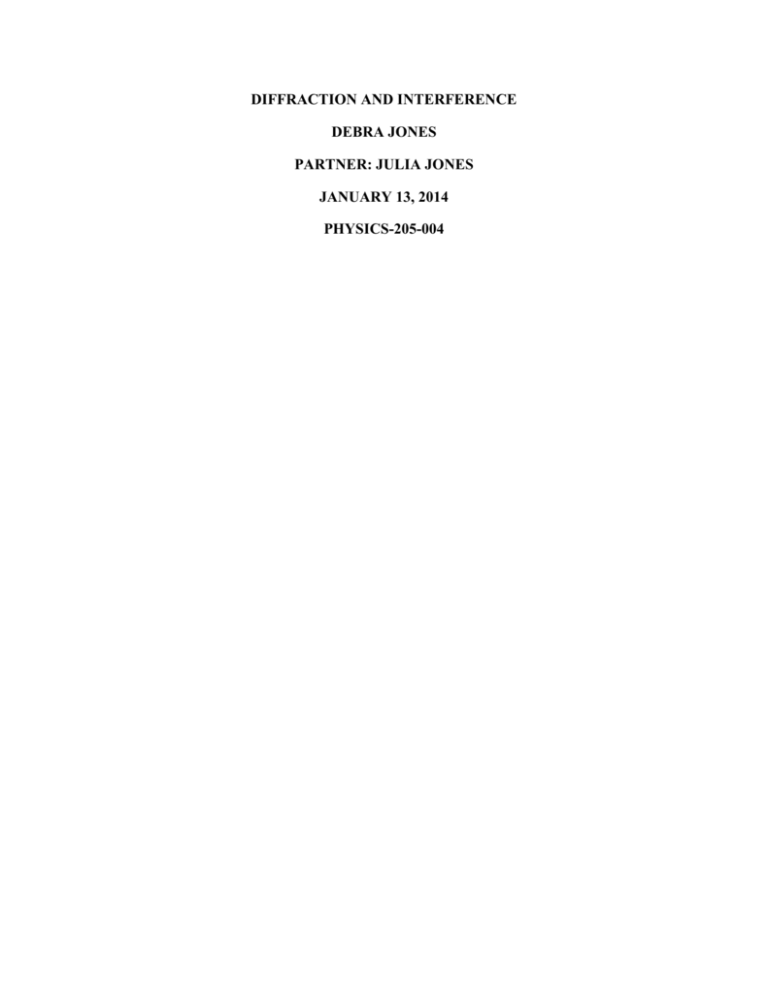
DIFFRACTION AND INTERFERENCE DEBRA JONES PARTNER: JULIA JONES JANUARY 13, 2014 PHYSICS-205-004 Abstract: The purpose of this experiment was to measure the wavelength of light produced by a green and a red laser, and to predict how the light interacted with the barrier based on that wavelength. This was done by projecting the lasers onto a piece of paper and measuring the first five minima. Using the Length from the laser to the paper, the length of the minima from the center, p, and a (or d for double slit), the wavelengths were able to be calculated for three out of the four laser trials. For the single slit green laser, a was 0.08 mm for p=1-5. Using the recorded measurements, the wavelength of p=1,2,3,4,5 was calculated to be 5.02E-8 m, 5.02E-7m, 5.02E7m, 5.02E-7m, and 5.02E-7m. The average, standard deviation, and standard deviation of the mean for these wavelengths were calculated, and were found to be 4.115E-07m. 2.02088E-7m, and 9.03766E-08m respectively. The percent error between the average wavelength and the expected wavelength of a green laser was calculated to be 21.278%. A possible source of error could be due to the laser not being aligned at the center properly. This procedure was repeated for both the single slit red laser and the double slit red laser. For the single slit red laser, a=0.16mm, and the wavelengths were 3.34728E-7m, 4.01674E-7m, 6.0251E-7m, 6.0251E-7m, and 6.0251E-7m for p=1,2,3,4 and 5. The percent error for these wavelength values were 59.26%, 46.678%, 8.927%, 8.927%, and 8.927% respectively. For the double slit red laser, d=0.5mm, and the wavelengths for p=1,2,3,4, and 5 were 4.1841E-6m, 4.1841E-6m, 3.8354E-6m, 3.9226E-6m, and 3.7657E-6m. The percent error for each of these values was 664.3%, 664.3%, 598.76%, 615.15%, and 585.66%. Possible sources of error for these two trials could be due to the laser not being aligned at the center point, or could be due to human error in reading the ruler during the measurements of the minima. Using the values collected from the single slit red laser trial, yd(a/L) was plotted versus p, and its slope was used to determine the wavelength. LINEST was used to find this slope value and to find the slope error. These values were determined to be λ+/-Δλ=7.364E-08+/-2.152E08m. Discussion: 1) If the size of a was increased, the central maximum will get smaller, and there would be less diffraction. For the double slit diffraction pattern, the slit width of the double slits are responsible for the envelope. Smaller slit widths would make the peaks within the envelope more defined. 3) A) y(α)=0.00438 m y(β)=0.00324m y(γ)=0.002894 m y(δ)=0.00273m b) We must resolve all of our first order maxima to the precision of the value of a=0.01 mm

